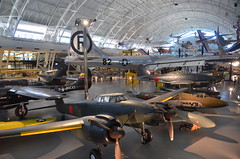T62 Solution heat-treated from annealed or F temper and articially agedby the user (as opposed to the producer), for example, 6066-T62.While the temper designations for wrought alloys are grouped accordingto whether the strength level was obtained by strain-hardening or by thermaltreatment, articial aging is the more important distinction for structural designpurposes because it affects the shape of the stress-strain curve.
The AluminumSpecication gives one set of buckling constant formulas for the articiallyaged tempers (T5 through T10), and another set of formulas thatapplies to both the non-heat-treated alloys (H), as well as to the heat-treatedalloys that have not been articially aged (T1 through T4). Thesebucklingconstants are discussed in detail in Section 5.2.1.You’ll occasionally encounter tempers that don’t match any of the onesdescribed above, such as 6063-T53. Individual producers register these withthe Aluminum Association, which publishes their properties in Tempers forAluminum and Aluminum Alloy Products (25).
Aluminum’s markets have developed gradually over the 100-year history ofcommercial production of the metal. Its rst use was cooking utensils in the1890s, followed by electrical cable shortly after 1900, military uses in the1910s, and aircraft in the 1930s. Aluminum’s use in construction beganaround 1930, when landmark structures, such as the national Botanic GardenConservatory in Washington, DC, and the Chrysler and Empire State Buildingsin New York City were erected with aluminum structural components.
Aluminum didn’t really crack the construction market until after World WarII, when aluminum was rst used to clad buildings.
This was done with theadvent of extrusions and curtainwall technology, discussed further below. The1960s saw the rapid expansion of aluminum’s largest market, packaging. Inthe 1990s, aluminum use in transportation has grown markedly, especially inautomobiles and light trucks.
Aluminum’s most recent markets are its largest—transportation, packaging,and construction, in that order—and together they account for two-thirds ofU.S. aluminum consumption (Table 2.5).Applications of aluminum can be divided into two classes: structural andnonstructural. Structural applications are those for which the size of the partis driven primarily by the load which it must support; nonstructural applicationsare the rest. About half the transportation and building and construction.
Aluminum didn’t really crack the construction market until after World WarII, when aluminum was rst used to clad buildings. This was done with theadvent of extrusions and curtainwall technology, discussed further below. The1960s saw the rapid expansion of aluminum’s largest market, packaging. Inthe 1990s, aluminum use in transportation has grown markedly, especially inautomobiles and light trucks.
Aluminum’s most recent markets are its largest—transportation, packaging,and construction, in that order—and together they account for two-thirds ofU.S. aluminum consumption (Table 2.5).Applications of aluminum can be divided into two classes: structural andnonstructural. Structural applications are those for which the size of the partis driven primarily by the load which it must support; nonstructural applicationsare the rest. About half the transportation and building and construction.
I’m Jerri Lily , which offers quality products such as Emergency Diesel Generators, High Frequency Online UPS Manufacturer, and many more. Know more , please visit Emergency Diesel Generators .




